The Great Peacock Globular (Pavo Globular Cluster) is a bright globular cluster located approximately 13,000 light-years away in the southern constellation Pavo (the Peacock). With an apparent magnitude of 5.4 and an apparent size of 20.4 arcminutes, it can be observed in binoculars and small telescopes. The cluster is listed as NGC 6752 in the New General Catalogue and Caldwell 93 in the Caldwell catalogue.
The Pavo Globular Cluster has an estimated age of 11.78 billion years. It lies 17,000 light-years from the Galactic centre. It is the fourth brightest globular cluster in the sky, after Omega Centauri (NGC 5139, Caldwell 80) in the constellation Centaurus, 47 Tucanae (NGC 104, Caldwell 106) in Tucana, and the Great Sagittarius Cluster (Messier 22, NGC 6656) in Sagittarius. It is only slightly brighter than Messier 4 near Antares in Scorpius and Messier 5 in Serpens.
Globular clusters are massive, dense, spherical conglomerations of stars tightly bound by gravity. They are among the oldest objects known in the universe. These clusters are typically found in the outer regions of their host galaxies, in the galactic halos. The Pavo Globular Cluster is one of more than 150 globular clusters orbiting our Milky Way galaxy.
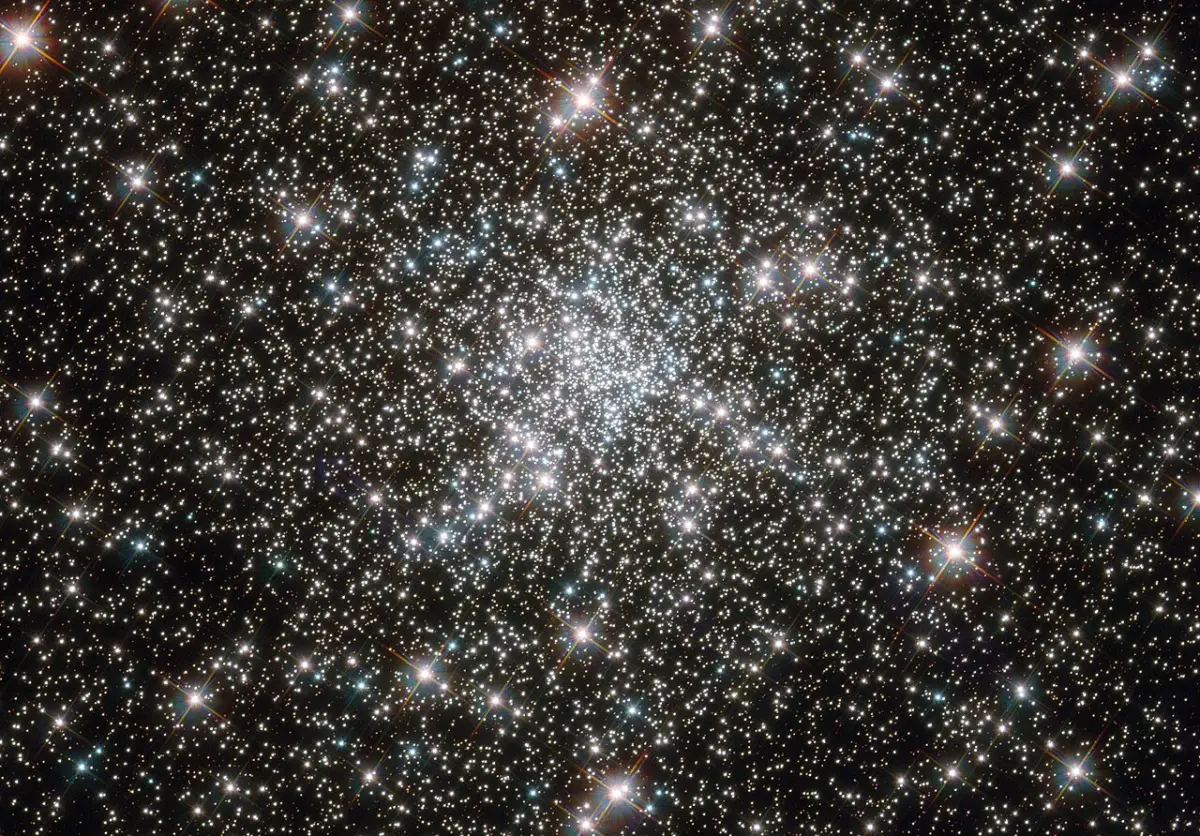
Looking like a hoard of gems fit for an emperor’s collection, this deep sky object called NGC 6752 is in fact far more worthy of admiration. It is a globular cluster, and at over 10 billion years old is one the most ancient collections of stars known. It has been blazing for well over twice as long long as our Solar System has existed. NGC 6752 contains a high number of “blue straggler” stars, some of which are visible in this image. These stars display characteristics of stars younger than their neighbours, despite models suggesting that most of the stars within globular clusters should have formed at approximately the same time. Their origin is therefore something of a mystery. Image credit: ESA/Hubble & NASA (CC BY 3.0)
The cluster contains three distinct populations of stars. The bluest population is believed to have a primordial composition consistent with that of the stars in the Milky Way’s halo. The redder populations exhibit sodium and helium enrichment. The three populations were discovered using photometry with the Hubble Space Telescope (HST).
The Great Peacock Globular has a dense core region about 1.3 light-years in diameter. The cluster is believed to have undergone core collapse. It has the Shapley-Sawyer Concentration Class VI, indicating an intermediate mild concentration of stars towards the core.
Observations with the Chandra X-ray Observatory in 2021 revealed a total of 51 X-ray sources within the 1’.9 half-radius of the cluster. Some of these were background galaxies and active galactic nuclei, while others were chromospherically active binary systems, red giant stars, and cataclysmic variables. Three of the detected sources are associated with millisecond pulsars.
NGC 6752 contains many binary stars and blue stragglers. Astronomers estimate that up to 38 percent of the stars in the cluster’s core are binary systems. Blue stragglers are stars that appear younger, hotter, bluer and more luminous than other cluster members. These stars typically reside near the cores of globular clusters. They are believed to form in collisions of smaller stars in the densely populated central regions of these clusters.
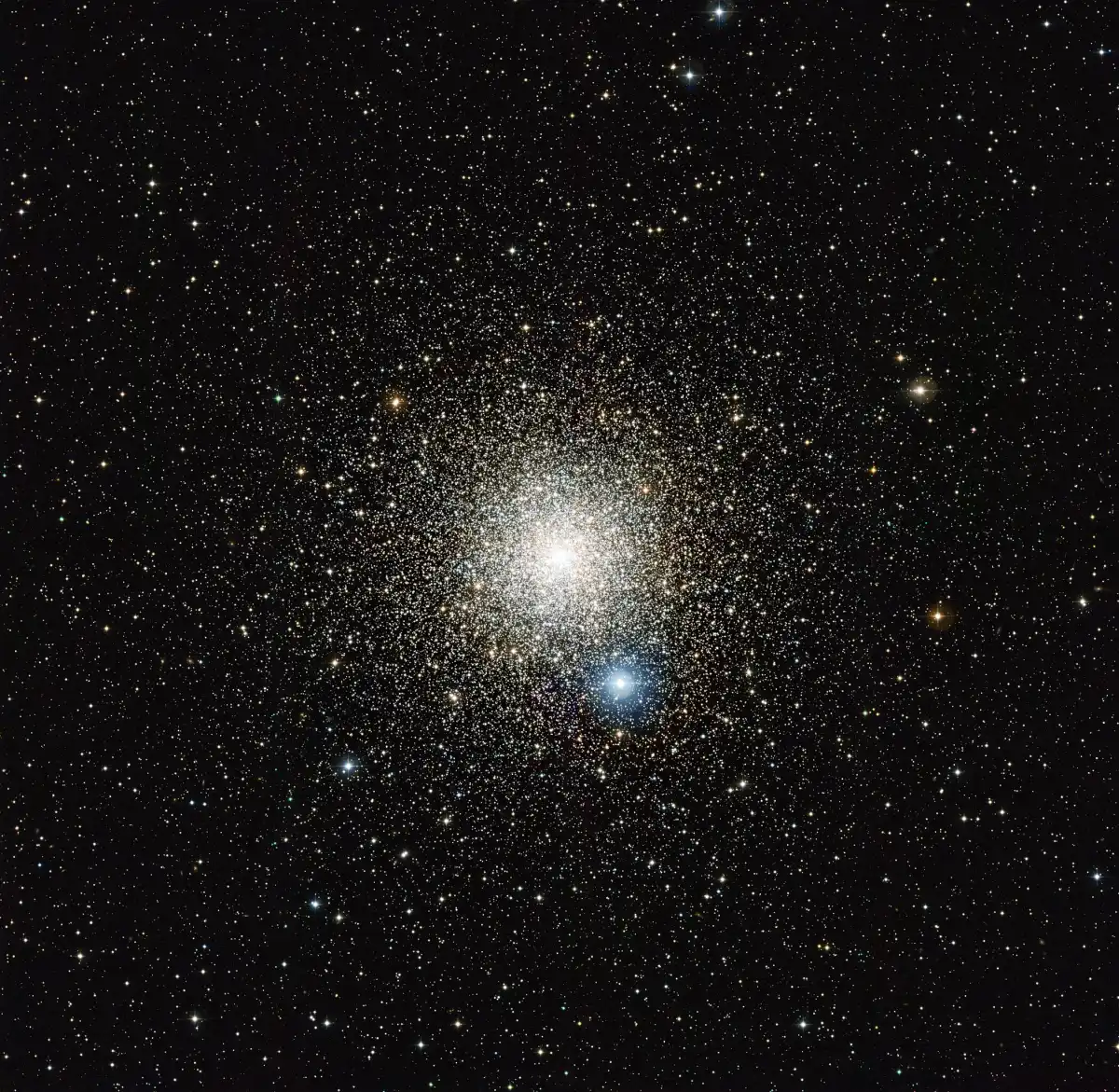
This image from the Wide Field Imager on the MPG/ESO 2.2-metre telescope at the La Silla Observatory in Chile shows the globular star cluster NGC 6752 in the southern constellation of Pavo (The Peacock). Studies of this cluster using ESO’s Very Large Telescope have unexpectedly revealed that many of the stars do not undergo mass-loss at the end of their lives. Image credit: European Southern Observatory (ESO) (CC BY 4.0)
Facts
The globular cluster NGC 6752 was discovered by the Scottish astronomer James Dunlop from the Parramatta Observatory near Sydney, Australia, on June 30, 1826. Dunlop spotted the cluster with his 9-inch reflector and listed it as object number 295. After multiple observations, he described it as a “pretty large and very bright nebula, 5’ or 6’ diameter, irregular round figure, easily resolved into a cluster of small stars, exceedingly compressed at the centre.” Dunlop proposed that the object may be two clusters appearing in the same line of sight.
English astronomer John Herschel observed the Pavo Globular Cluster from the Cape of Good Hope in South Africa on July 12, 1834. He listed it as h 3778 in his catalogue, describing it as a “globular cluster; bright; rich; pretty suddenly brighter in the middle; 7’.”
Danish astronomer John Louis Emil Dreyer, who included the cluster in his New General Catalogue of 1888, described the object as a “globular cluster, bright, very large, irregularly round, well resolved, clearly consisting of stars, stars from 11th to 16th magnitude.”
Location
The Great Peacock Globular lies in the far southern sky. It is invisible from Europe and most of North America. It appears 9.25 degrees east and 3.25 degrees north of Peacock (Alpha Pavonis), the brightest star in the constellation Pavo, and 1.5 degrees east of the fainter Omega Pavonis (mag. 5.14). Omega Pavonis lies roughly halfway between Peacock in Pavo and Delta Arae in the constellation Ara (the Altar).
NGC 6752 can be found about two thirds of the way from Arkab Prior and Arkab Posterior in Sagittarius to Kappa Pavonis in Pavo, along the line drawn from the Persian (Alpha Indi) to Eta Pavonis. The Milky Way’s twin NGC 6744 (the Pavo Galaxy) lies in the same region of the sky, about 4 degrees south of NGC 6752.
With an apparent magnitude of 5.4, the Pavo Globular Cluster is visible to the unaided eye in exceptionally good conditions, from areas with minimal light pollution. Binoculars will reveal a ball of stars roughly three quarters the size of the full Moon.
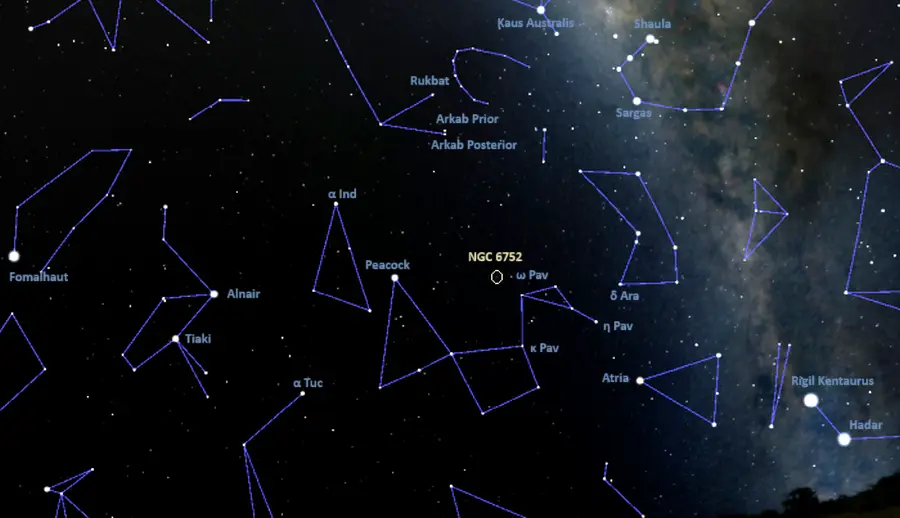
Great Peacock Globular location, image: Stellarium
The best time of the year to see the Great Peacock Globular and other deep sky objects in Pavo is during the month of August, when the constellation appears higher above the horizon in the early evening.
At declination -60°, NGC 6752 is best seen from the southern hemisphere. It never rises for observers north of the latitude 30° N and only appears low in the sky from the northern tropical latitudes. The cluster is best observed from locations south of the equator from June to October.
Great Peacock Globular – NGC 6752
| Constellation | Pavo |
| Object type | Globular cluster |
| Class | VI |
| Right ascension | 19h 10m 52.11s |
| Declination | –59° 59′ 04.4″ |
| Apparent magnitude | 5.4 |
| Apparent size | 20.4′ |
| Distance | 13,000 light-years (4,000 parsecs) |
| Size | ~110 light-years |
| Age | 11.78 billion years |
| Mass | 1.4 × 105 M☉ |
| Metallicity [Fe/H] | -1.24 dex |
| Names and designations | Great Peacock Globular, Pavo Globular Cluster, NGC 6752, Caldwell 93, C93, ESO 141-SC30, GCl 108, C 1906-600, [KPS2012] MWSC 3062 |
Images
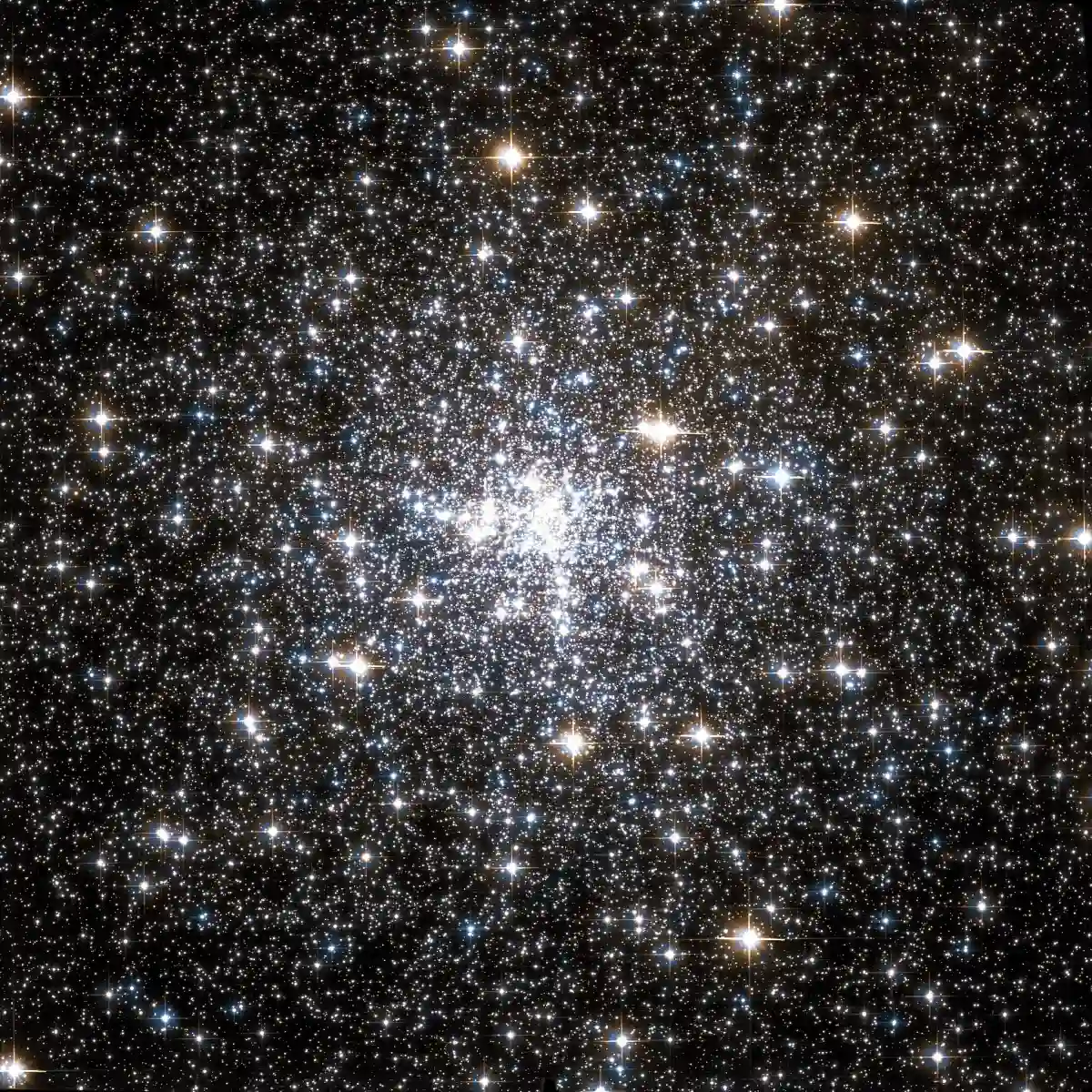
NGC 6752 captured by the Hubble Space Telescope (HST), credit: NASA, ESA, STScI, Hubble (PD)
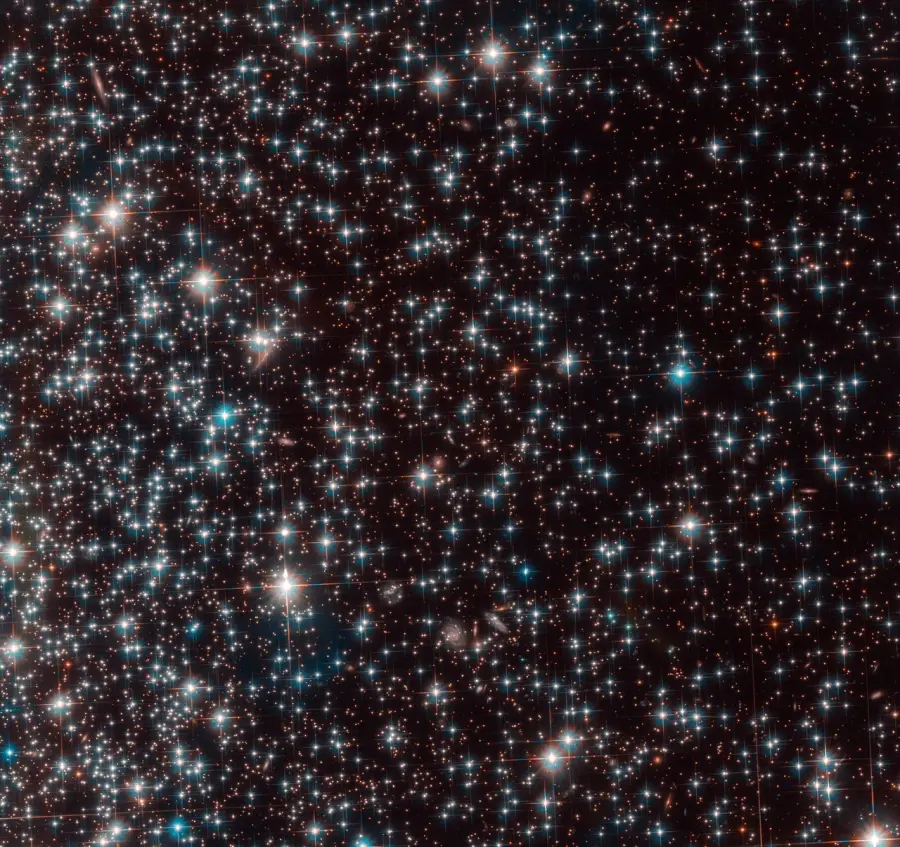
This image, taken with the NASA/ESA Hubble Space Telescope, shows a part of the globular cluster NGC 6752. The observations were made to study white dwarfs within it and to use these stars to measure the age of the globular cluster. Analysing the data, astronomers discovered a previously unknown galaxy behind the globular cluster. The galaxy, nicknamed Bedin 1, is visible as a collection of faint stars at the top left of the image. Credit: ESA/Hubble, NASA, Bedin et al. (PD)
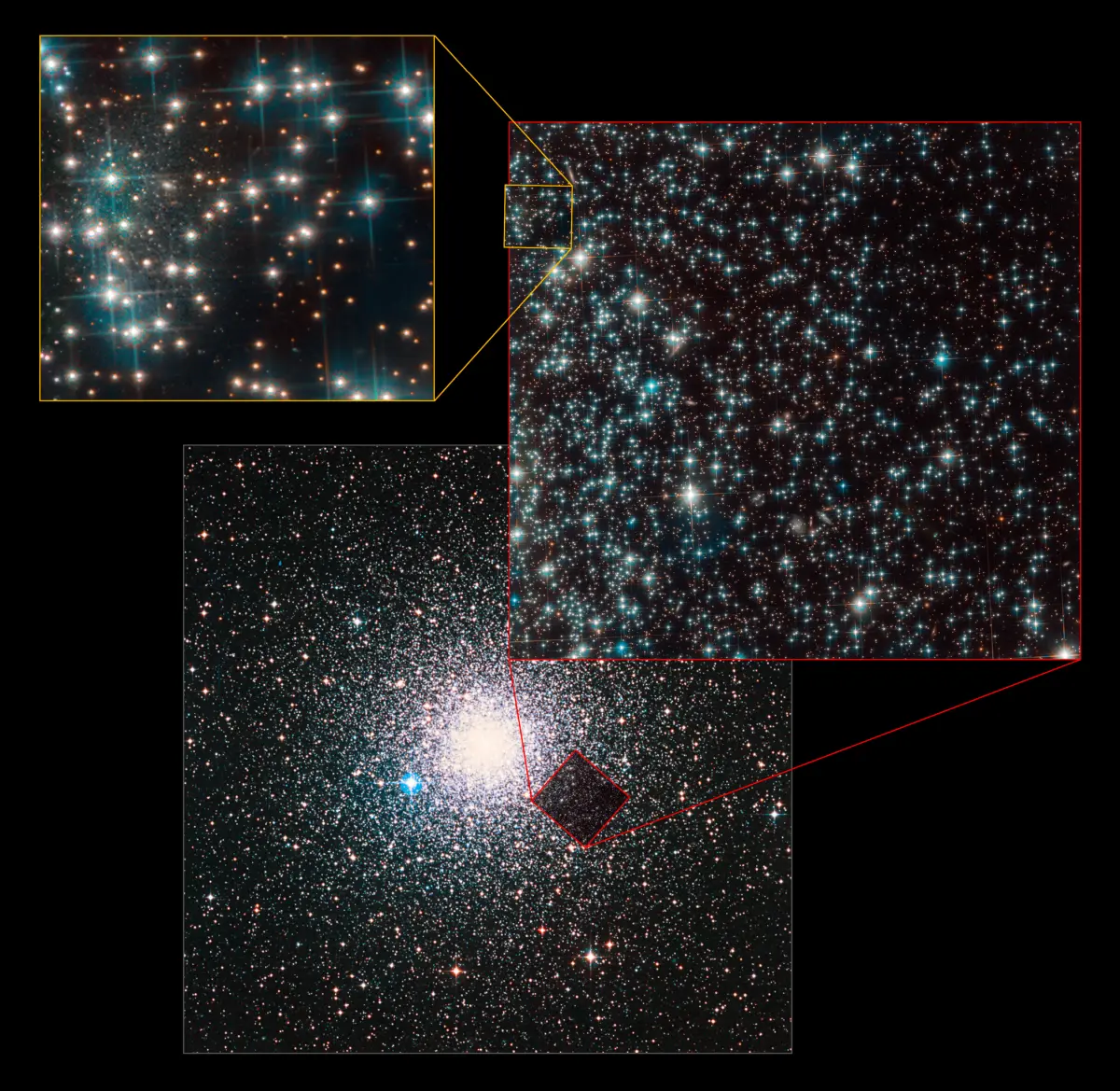
Location of the galaxy Bedin 1, credit: NASA, ESA, L. Bedin (Astronomical Observatory of Padua, Italy), and Digitized Sky Survey 2 (PD)
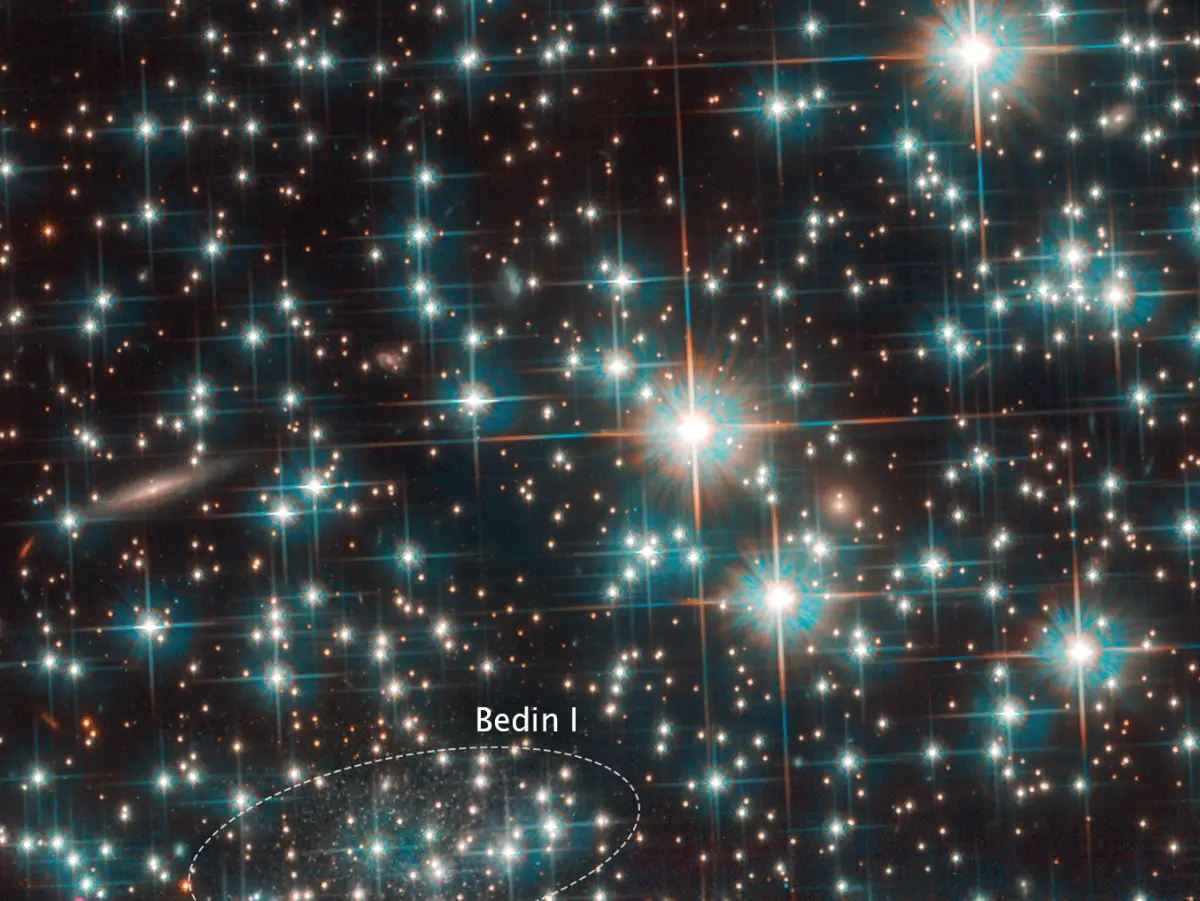
This is a Hubble Space Telescope image of a concentration of stars within the globular cluster NGC 6752. Hidden among the stars is an image of a background galaxy that is much farther away. The diminutive galaxy, named by its discoverers as Bedin 1, measures only around 3,000 light-years at its greatest extent — a fraction of the size of the Milky Way. Not only is it tiny, but it is also incredibly faint. These properties led astronomers to classify it as a dwarf spheroidal galaxy that is as old as the universe. Credit: NASA, ESA, and L. Bedin (Astronomical Observatory of Padua, Italy) (PD)
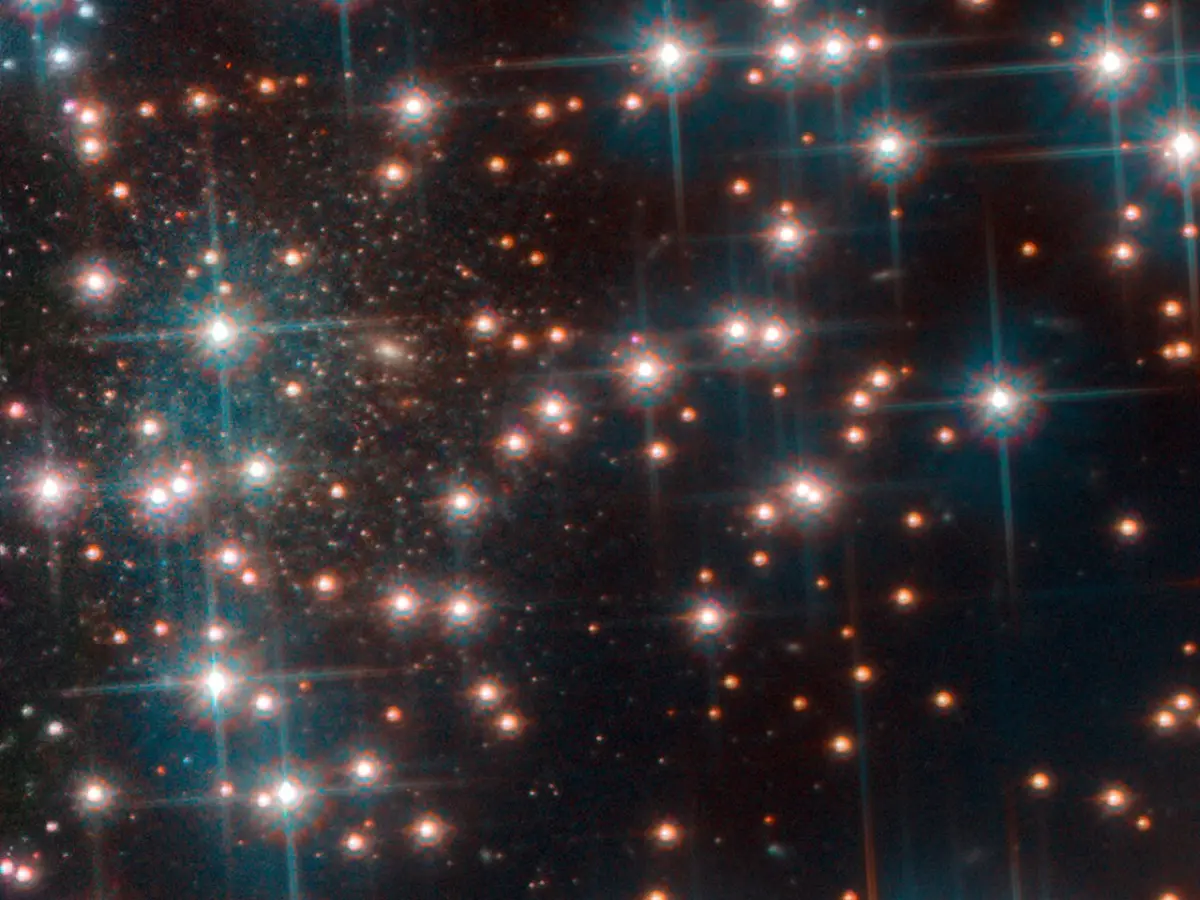
This image, taken with Hubble’s Advanced Camera for Surveys shows a part the globular cluster NGC 6752. Behind the bright stars of the cluster a denser collection of faint stars is visible — a previously unknown dwarf spheroidal galaxy. This galaxy, nicknamed Bedin 1, is about 30 million light-years from Earth. Credit: NASA, ESA, Hubble (CC BY 4.0)